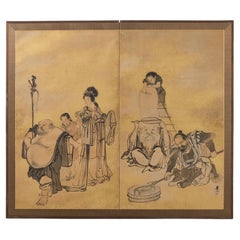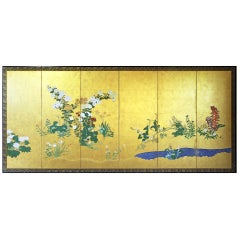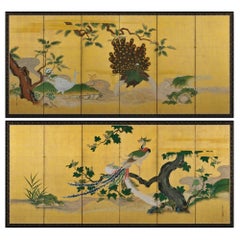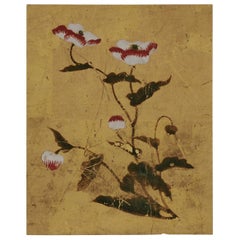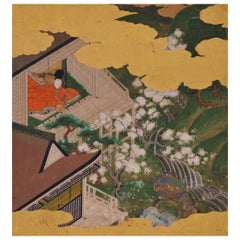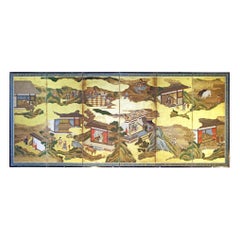Gold Paintings and Screens
to
6
150
29
232
18
2
1
63
110
59
20
21
12
4
2
1
2
3
2
12,599
769
739
703
528
244
235
221
13
6
252
245
249
6
2
1
1
1
Material: Gold
Japanese Edo Two Panel Screen Deities by Yokoyama Kazan
Located in Rio Vista, CA
Whimsical Japanese late Edo period two-panel screen circa 1800 by Yokoyama Kazan (Japanese 1784-1837). The screen depicts four of the seven Gods or deities ...
Category
19th Century Japanese Edo Antique Gold Paintings and Screens
Materials
Brass, Gold Leaf
Edo Landscape Japanese Folding Screen
Located in Brescia, IT
Refined work by a painter from the first half of the 19th century, from the landscape of the "Rinpa" school by a painter from the end of the 18th century, the Rinpa school.
Six panels painted in ink on gold leaf and "gofun" on vegetable paper.
The flowers are made with the "gofun" technique, natural or pigmented white oyster powder.
Rinpa is one of the major historical schools of Japanese painting. The style was consolidated by the brothers Ogata Korin (1658–1716) and Ogata Kenzan (1663–1743).
This folding screen has a very clean design that leaves plenty of room for the beautiful golden landscape.
It comes flat and you can easily hang it with our hooks.
Lucio Morini...
Category
18th Century Japanese Edo Antique Gold Paintings and Screens
Materials
Gold Leaf
Japanese Screen Pair, circa 1730, Peacocks and Phoenix, Kano School
Located in Kyoto, JP
Phoenix and Peacocks.
A pair of six-panel Japanese folding screens by Tsunetake Yotei (n.d.)
First half of the 18th century.
The signature reads 67 year old Tsunetake.
The seals read:
-Tsunetake no in,
-Yotei,
-Seishin
Dimensions:
Each screen – H. 69” x W. 149” (176 cm x 378 cm)
A pair of Kano Grand Picture (Waga) screens depicting phoenix and peacocks rich with symbolic meaning. Dating to the first half of the 18th century, from the Kobikicho Kano school in Edo, this pair of folding...
Category
Early 18th Century Asian Edo Antique Gold Paintings and Screens
Materials
Gold Leaf
18th Century Japanese Floral Paintings, Set of 5, Mineral Pigments on Gold Leaf
Located in Kyoto, JP
A set of 5 Japanese floral paintings from the 18th century. Each painted with mineral pigments directly applied to gold leaf. They were originally designed to be mounted on the leave...
Category
Mid-18th Century Japanese Edo Antique Gold Paintings and Screens
Materials
Gold Leaf
Japanese Painting, 17th Century, Tale of Genji, Tosa School
Located in Kyoto, JP
Illustration to an unidentified chapter of the Tale of Genji (Genji Monogatari)
Tosa School (second half of the 17th Century)
Ink, pigment, gofun and...
Category
Late 17th Century Japanese Edo Antique Gold Paintings and Screens
Materials
Gold Leaf
Japanese Tosa School Framed Six Panel Screen Gold Leaf
Located in Brescia, IT
Japanese six-panel screen of the famous "Tosa school" made by an anonymous artist of the mid-18th century, work painted in the classic way with colored pigments and inks on vegetable...
Category
Mid-18th Century Japanese Edo Antique Gold Paintings and Screens
Materials
Gold Leaf
Japanese Folding Screen Six Panels Painted on Gold Leaf
Located in Brescia, IT
Paravento a sei pannelli di scuola giapponese Kano: paesaggio con bellissime ed eleganti gru vicino al fiume, con alberi di pino e sakura.
Dipinto a mano con pigmenti minerali ed inc...
Category
Early 19th Century Japanese Edo Antique Gold Paintings and Screens
Materials
Gold Leaf
Japanese Meiji Eight Panel Screen Village Landscape with Figures
Located in Rio Vista, CA
Large 19th century Japanese Meiji period eight panel byobu screen featuring a panoramic village landscape. The serene painting depicts agricultural scenes with villagers engaged in p...
Category
19th Century Japanese Meiji Antique Gold Paintings and Screens
Materials
Gold Leaf
Japanese Screen, Early 20th Century Wagtail & Chrysanthemum by Ishizaki Koyo
Located in Kyoto, JP
Ishizaki Koyo (1884-1947)
Wagtail & Chrysanthemum
Early 20th century
Folding screen in two-panels. Ink, pigments and gofun on gold leaf.
Sign: Koyo
Seal: Koyo
This ...
Category
Early 20th Century Japanese Taisho Gold Paintings and Screens
Materials
Gold Leaf
Japanese Screen Pair, Tigers by Kishi Renzan, Late Edo Period
Located in Kyoto, JP
Kishi Renzan (1804-1859)
Tigers
Pair of six-panel Japanese screens.
Ink and gold-leaf on paper.
In this monochromatic pair of six-fold Japanese screens painted on gold-leaf, Kishi Renzan has created a breathtaking composition of a family of tigers. The screens are filled with a sense of drama which is conveyed by both the subject matter and the wet, expressive brushwork. The running mountain stream and the towering waterfall allude to refreshment during the summer months and we feel the tiger families familiarity and security within their environment. Renzan’s master, Kishi Ganku...
Category
Mid-19th Century Asian Edo Antique Gold Paintings and Screens
Materials
Gold Leaf
Japanese Byobu - Japanese Folding Screen Gold Leaf
Located in Brescia, IT
Floral scene of a "Rimpa School" garden with polychrome chrysanthemum flowers.
Six-panel screen painted with pigments on golden rice paper of good size and well preserved.
Bold color...
Category
Early 19th Century Japanese Edo Antique Gold Paintings and Screens
Materials
Gold Leaf
Pair of Japanese Edo Rimpa School Screens after Tawaraya Sōtatsu
Located in Rio Vista, CA
Impressive pair of 17th century Japanese Edo period Rinpa school screens made in the manner and style of Autumn Grasses by Tawaraya Sōtatsu (1570-1640). Beautifully decorated with wi...
Category
17th Century Japanese Edo Antique Gold Paintings and Screens
Materials
Gold Leaf
Antique kimono textile art "Prosperity Tree" by ikasu Black, Japan
By Kimono ikasu
Located in Setagaya City, JP
This work uses an antique kimono fabric dated Taisho era (early 1910th), with a pine tree motif, and arranges it so that it looks like a tree decorated with various auspicious symbols - persimmons, pines, peonies, etc.
The line in the middle symbolizes “kintsugi” - concept of wabi-sabi, which values imperfection, impermanence, and the beauty of aging.
It is elegantly framed with paulownia wood originally used for kimono chest-of-drawers, and is filled with storytelling and sense of luxury.
I used pieces of kimono that could no longer be used as clothing and kiritansu chest-of-drawers that would normally be discarded to create the ultimate upcycled piece.
<< Explanation and meaning of pattern and colors >>
The art work features the matsu - pine pattern, which depicts the Japanese pine tree spreading over deep black fabric. It appears as if the pine dranches are decorated with various auspicious symbols - persimmons, pines, peonies, etc.
In East Asia, the pine tree is revered as a symbol of longevity due to its vibrant green leaves, even during the winter season.
In Japan, it's often referred to as the "evergreen tree" because its leaves remain green throughout the year, making it a symbol of good fortune that has been cherished for a long time.
<< Characteristics of the fabric >>
The fabric is hand-painted in traditional Japanese technique "yuzen".
<< About the frame >>
Kiritansu - chest-of-drawers for kimono, is traditionally made from paulownia wood, a uniquely Japanese material closely tied to the world of kimonos.
Paulownia wood is known as the lightest wood in Japan, prased for its natural luster, resistance to moisture, and resilience against cracking. Since ancient times, it has been used in crafting furniture, chests, and musical instruments.
During the Edo period, it became customary to store cherished kimonos in paulownia chests...
Category
Early 20th Century Japanese Japonisme Gold Paintings and Screens
Materials
Gold Leaf
Large Japanese 6-panel byôbu 屏風 (folding screen) with chrysanthemum garden
Located in Amsterdam, NL
A very colourful and captivating large six-panel byôbu (folding screen) with a refined continuous painting of a luscious flower garden filled with many different types of chrysanthemums (kiku), next to a winding river.
This multi-coloured painting is set on a shiny gold-leaf background, and the chrysanthemum flowers are painted by using shell paste (gofun) in low relief.
Several clutches with a great variety of chrysanthemum flowers are in full bloom and they each show their unique form and colour. Varying from white, red, yellow and pink. The flowers bloom all around and on different kinds of bamboo fences and trellises.
In Japan chrysanthemums are believed to represent happiness, love, longevity and joy.
The panels are surrounded by two silk borders, a thin black one, and a wide brown one. The screen is protected by a black and red negoro’nuri...
Category
Late 19th Century Japanese Antique Gold Paintings and Screens
Materials
Gold Leaf
Late 17th Century Japanese Screen. Puppy and Kittens on Gold Leaf.
Located in Kyoto, JP
Anonymous
Late 17th century
Puppy & Kittens
A six-panel Japanese screen. Ink, color, gofun, gold-leaf and gold-fleck on paper.
A medium sized late 17th century Japanese screen fe...
Category
Late 17th Century Japanese Edo Antique Gold Paintings and Screens
Materials
Gold Leaf
Japanese Kano School Four Panel Screen Birds and Owl
Located in Rio Vista, CA
Amazing 19th century Japanese Meiji period four-panel byobu screen featuring painted panels depicting egrets, heron, pheasants, songbirds, and an owl. Painted with ink and natural co...
Category
19th Century Japanese Meiji Antique Gold Paintings and Screens
Materials
Gold Leaf
Late 19th century (Meiji period) painting depicting tiger
Located in Fukuoka, JP
Antique Tiger Painting on Paper – Meiji Period
A striking depiction of a tiger, painted on paper and signed by the artist. This work was originally part of a Japanese byobu folding ...
Category
Late 19th Century Japanese Meiji Antique Gold Paintings and Screens
Materials
Gold Leaf
Japanese Screen mid Edo gold leaf
Located in Brescia, IT
This 18th century six-panel screen is truly special. The author is unknown, but his singular genius in portraying dozens of chrysanthemum flowers created with the white of the "gofun...
Category
Mid-18th Century Japanese Edo Antique Gold Paintings and Screens
Materials
Gold Leaf
Japanese Asian Large Edo Six-Panel Folding Byobu Screen Landscape Monkeys Trees
Located in Studio City, CA
An absolutely gorgeous, wonderfully composed six-panel Japanese Byobu folding screen/room divider depicting a family of playful monkeys among the blooming trees and mountainous lands...
Category
Early 19th Century Japanese Edo Antique Gold Paintings and Screens
Materials
Gold Leaf
Early Edo Period Chinese-Inspired Screen
Located in Fukuoka, JP
This remarkable screen from the early Edo period, circa the 17th century, showcases the influence of early Chinese art forms with its intricate ink work on a gold leafed surface. The...
Category
17th Century Japanese Edo Antique Gold Paintings and Screens
Materials
Gold Leaf
Peacock Chinoiserie Wallpaper Hand Painted Wallpaper on Champagne Metallic
Located in Wuxi, 32
If you love the look of De Gournay wallpaper but not the price, this is for you. Measures: 36" wide x 91" height
The colorways in this sections present our latest colorways, which c...
Category
21st Century and Contemporary Chinese Gold Paintings and Screens
Materials
Gold Leaf
Japanese Edo Six-Panel Haboku Landscapes of Seasons
Located in Rio Vista, CA
19th century Japanese Edo period six-panel screen painted in Haboku (splashed ink) style. Depicts Four Seasons landscape scenes with two portraits of Chinese sages. One sage is trave...
Category
19th Century Japanese Edo Antique Gold Paintings and Screens
Materials
Gold Leaf
Japanese Edo Six Panel Screen Merrymaking in the Chinese Countryside
Located in Rio Vista, CA
Large 19th century Japanese Edo period six panel folding byobu screen made in the Kano school style. Beautifully crafted with signature after Kano Tan'yu. Ink and natural color pigme...
Category
19th Century Japanese Edo Antique Gold Paintings and Screens
Materials
Gold Leaf
20th Century Chinese Export Six Panel Gold Leaf Coromandel Screen
Located in Rio Vista, CA
Late Qing, early republic period style Chinese export six-panel coromandel screen featuring a pavillion with figures engaged in leisurely activities on a dramatic gilt gold leaf back...
Category
20th Century Chinese Chinese Export Gold Paintings and Screens
Materials
Brass, Gold Leaf
Edo Period Seasonal Transition Screen
Located in Fukuoka, JP
Edo Period Seasonal Transition Screen
Period: Edo
Size: 368 x 153 cm
SKU: PTA148
This exquisite six-panel screen, adorned with golden flakes, beautifully portrays the seamles...
Category
19th Century Japanese Edo Antique Gold Paintings and Screens
Materials
Gold Leaf
Japanese Folding Screen Landscape paint on Gold Leaf Six Panels
Located in Brescia, IT
Folding screen depicting a landscape by a painter of the Rinpa school, early 19th century.
Six panels painted in ink on gold leaf and "gofun" on vegetable paper.
Rinpa is one of the ...
Category
Early 19th Century Japanese Edo Antique Gold Paintings and Screens
Materials
Gold Leaf
Japanese Edo Six Panel Screen Yoshitsune and Benkei
Located in Rio Vista, CA
Spectacular 19th century Japanese late Edo period six-panel byobu screen depicting Yoshitsune and Benkei, two heroes of Japanese folklore. Crafted in ink and natural color pigments on mulberry paper with thick gold leaf borders on each panel. The character Yoshitsune is seated under a blossoming cherry tree in full armor holding a fan. The warrior priest or monk Benkei is depicted kneeling on a leopard skin...
Category
19th Century Japanese Edo Antique Gold Paintings and Screens
Materials
Brass, Gold Leaf
$3,400 Sale Price
29% Off
Japanese Six Panel Screen Battle of Uji Bridge
Located in Hudson, NY
The first battle at Uji was in 1180 and was the beginning of the Heike Wars.
This screen depicts a famous scene from the Heike Wars. Two Heike generals, Sasaki Takatsuna and Kajiwa...
Category
Early 19th Century Japanese Edo Antique Gold Paintings and Screens
Materials
Gold Leaf
Japanese Six-Panel Screen, a Garden for All Seasons
Located in Hudson, NY
An imaginary garden with flowers from all seasons including spring lilies, summer hibiscuses, autumn chrysanthemums, and winter berries. Wild autumn grasses move in a soft breeze wit...
Category
1890s Japanese Meiji Antique Gold Paintings and Screens
Materials
Gold Leaf
Antique Japanese Six-Panel Screen by Kano Chikanobu "Shushin"
Located in Prahran, Victoria
Late 17th century Kano school peony landscape screens. Both screens signed: Hogan Josen Fujiwara Chikanobu Hitsu - Kano Chikanobu (Shushin) (1660 - 1728...
Category
Early 18th Century Japanese Edo Antique Gold Paintings and Screens
Materials
Gold Leaf
17th Century Japanese Screen. Karako Asobi: Chinese Children at Play.
Located in Kyoto, JP
Anonymous Kano school artist
17th century
"Karako Asobi: Chinese Children at Play"
A two-panel Japanese Furosaki screen. Ink, pigment, gofun and gold-leaf on paper.
This small Japanese Karako folding screen vividly depicts various games played by children wearing wearing elaborate Chinese T'ang dynasty costumes. They are dressed in plumed and tasseled hats, ornate jackets, baggy pants, and cloth slippers typical of T'ang period Chinese court dress. The children are depicted pulling a younger child along in a cart, carrying another child as if an important official, riding a wooden horse, leading a puppy and carrying a tethered bird. Executed in fine-quality pigments on gold leaf, the detail, variety and size of the figures is noteworthy. Also notable is the size of this screen itself, which denotes it as a Furosaki screen. A Furosaki screen is part of the equipment used for the Japanese tea-ceremony. It is traditionally placed on tatami mats behind the brazier highlighting the utensils and providing a focal point.
Karako is a Japanese term used in art with the depiction of Chinese children playing...
Category
17th Century Edo Antique Gold Paintings and Screens
Materials
Gold Leaf
Summer Flowers Eight-Panel Botanical Screen
Located in Fukuoka, JP
Summer Flowers Eight-Panel Botanical Screen
Period: Late Edo
Size: 352x117 cm (138x46 inches)
SKU: PTA42
Immerse yourself in the splendor of late Ed...
Category
18th Century Japanese Edo Antique Gold Paintings and Screens
Materials
Gold Leaf
Japanese Six-Panel Screen Byobu With Chrysanthemums And Autumn Grass and Flower
Located in Torino, IT
The 19th Century Six-Panel Japanese folding screen "Byōbu" usually used in the most important Japanese house to stop wind and also to separate different space of the same big room de...
Category
Mid-19th Century Japanese Edo Antique Gold Paintings and Screens
Materials
Gold Leaf
19th Century Japanese Edo Screen Kano School Garden Terrace
Located in Rio Vista, CA
Fantastic 19th century Japanese Edo/Tokugawa period two-panel byobu screen featuring Chinese children frolicking on a garden terrace with a pavilion and large pine tree. Made in the ...
Category
19th Century Japanese Edo Antique Gold Paintings and Screens
Materials
Brass, Gold Leaf
Japanese Edo Six Panel Screen Chinese Children at Play
Located in Rio Vista, CA
Amazing 19th century Japanese Edo period six panel folding byobu screen depicting Chinese children at play. The screen alludes to the 100 children theme. ...
Category
19th Century Japanese Edo Antique Gold Paintings and Screens
Materials
Gold Leaf
Japanese Chinese Asian Large Six-Panel Folding Byobu Screen Mythical Landscape
Located in Studio City, CA
A gorgeous, strangely beautiful, unusually engaging, and alluring hand-painted large six-panel Japanese/Asian Byobu folding screen depicting an almost magical/ mythical nature scene ...
Category
18th Century Japanese Edo Antique Gold Paintings and Screens
Materials
Gold Leaf
Japanese Large Red Silk Brocade Gilded Two Panel Folding Screen
Located in Takarazuka, JP
Exquisite contemporary Japanese two panel folding screen or "byobu" featuring genryoku style handcrafted silk raised kimono in cream and gold needlework on a mesmerizing red background. Tagasode is the way a genryoku kosode kimono is hung over a kimono rack...
Category
21st Century and Contemporary Japanese Gold Paintings and Screens
Materials
Gold
Early 19th Century Japanese Six-Panel Screen, Tropical Garden
Located in Hudson, NY
With a banana leaf palm on the left, at water's edge with geese. Perhaps a scene from the southern islands. Mineral pigments on mulberry paper with gold leaf and a silk brocade border.
Category
Early 19th Century Japanese Antique Gold Paintings and Screens
Materials
Gold Leaf
Japanese Contemporary Black Gold Silk Brocade Two-Panel Folding Screen
Located in Takarazuka, JP
Exceptional Japanese contemporary two-panel "byobu" or folding screen featuring two graceful ladies dressed in elegant formal traditional Japanese kimonos. This folding screen is ins...
Category
21st Century and Contemporary Japanese Meiji Gold Paintings and Screens
Materials
Gold
Showa Delicate Floral Screen
Located in Fukuoka, JP
This graceful two-panel screen captures the essence of summer with its subtle depiction of slender grasses and fine lines, artfully arranged against a golden background. The screen e...
Category
20th Century Japanese Showa Gold Paintings and Screens
Materials
Gold Leaf
Paravento Giapponese a due pannelli
Located in Brescia, IT
Sempre alla ricerca di cose particolari abbiamo acquistato questo paravento giapponese da una collezionista di Osaka.
Un esempio di arte del novec...
Category
20th Century Japanese Showa Gold Paintings and Screens
Materials
Gold
Japanese Two Panel Screen: Young Bamboo on Gold
Located in Hudson, NY
Symbolizing the Sun, gold is often used in shrines and temples in Japan. Gold has been extensively recognized to represent wealth, while bamboo is said to bring good luck due to its ability to regenerate in the forest. A beautiful composition of the two together...
Category
Late 19th Century Japanese Antique Gold Paintings and Screens
Materials
Gold
Tibetan Thangka of Celebration Hand Painted Gilded
Located in Somis, CA
An exquisite hand painted Tibetan Thangka depicting 63 Buddhas with consorts and 5 protector Vajrabhairavas. Buddha seated dhyana asana on lotus throne at the center of the mandala i...
Category
2010s Nepalese Gold Paintings and Screens
Materials
Gold Leaf
$1,100 Sale Price
51% Off
Japanese Six Panel Screen: Clouds of Golden Mist
Located in Hudson, NY
Mineral pigments and gold on mulberry paper. Signature reads: Bunrei-Ga.
Category
Early 20th Century Japanese Gold Paintings and Screens
Materials
Gold
Romantic Edo Peacock Screen
Located in Fukuoka, JP
Romantic Edo Peacock Screen
Period: Edo
Size: 379x173 cm
SKU: PTA144
Step into a world of romance with our beautiful six-panel Edo screen adorned with golden leaves. This masterpie...
Category
18th Century Japanese Edo Antique Gold Paintings and Screens
Materials
Gold Leaf
Japanese Two Panel Screen: Bamboo on Gold
Located in Hudson, NY
Bamboo grove on a knoll with stylized gold mist. Mineral pigments on gold leaf with silk brocade border.
Category
Early 19th Century Japanese Antique Gold Paintings and Screens
Materials
Gold Leaf
Japanese Four Panel Screen: Early Spring Into Summer
Located in Hudson, NY
Japanese Four Panel Screen: Early Spring Into Summer, Meiji period (1868 -1912) painting of plum in bloom with red camellias on the right and peony and thistle on the left. A clutc...
Category
Early 1900s Japanese Meiji Antique Gold Paintings and Screens
Materials
Gold Leaf
Japanese Two-Panel Screen, Flower Garden
Located in Hudson, NY
Rimpa School painting featuring cascading chrysanthemums as well as cockscombs, summer wild flowers, and a climbing morning glory vine. Beautifully executed, fine painting in mineral...
Category
Mid-18th Century Japanese Edo Antique Gold Paintings and Screens
Materials
Gold Leaf
Late 19th century (Meiji period) painting depicting tiger
Located in Fukuoka, JP
Antique Tiger Painting on Paper – Meiji Period
A striking depiction of a tiger, painted on paper and signed by the artist. This work was originally part of a Japanese byobu folding ...
Category
Late 19th Century Japanese Meiji Antique Gold Paintings and Screens
Materials
Gold Leaf
18°th Century Japanese Gold Leaf Screen
Located in Brescia, IT
Four-panel folding screen depicting the famous legend of Hikaru Genji, a nobleman of extraordinary grace and beauty, and his gallant adventures at court.
The novel Genji Monogatari, ...
Category
18th Century Japanese Edo Antique Gold Paintings and Screens
Materials
Gold Leaf
Japanese Four Panel Screen: Autumn Flowers and Moon on Gold
Located in Hudson, NY
Mineral pigments on gold leaf.
Category
Early 20th Century Japanese Gold Paintings and Screens
Materials
Gold Leaf
Japanese Two-Panel Screen: Cranes on Gold
Located in Hudson, NY
Early Kano School painting of pine trees overlooking two beautifully painted cranes and floral design in a natural setting by water’s edge. Mineral pig...
Category
Late 18th Century Japanese Antique Gold Paintings and Screens
Materials
Gold, Gold Leaf
Pair of Japanese Six Panel Screens: Floral Landscape / Mother with Young
Located in Hudson, NY
The first screen is depicting a mother watching her young frolicking under pine tree by river's edge, the second, a mother and her young playing under a ...
Category
Late 18th Century Japanese Antique Gold Paintings and Screens
Materials
Gold Leaf
Two-panel screen of " Rinpa School"
Located in Brescia, IT
Floral scene of a Rimpa School garden with polychrome chrysanthemum flowers.
Two-panel screen painted in pigment on gilded rice paper of beautiful size and well preserved.
Bold color...
Category
20th Century Japanese Showa Gold Paintings and Screens
Materials
Gold Leaf
Six-panel gold leaf screen
Located in Brescia, IT
Large Japanese six-panel screen, ink, color, gold, and gold leaf on paper, depicting three scenes from Genji monogatari (The Tale of Genji), the vignettes punctuated by raised golden...
Category
Early 19th Century Japanese Edo Antique Gold Paintings and Screens
Materials
Gold Leaf
$16,738
Japanese Showa Four Panel Screen Snowy Winter Landscape
Located in Rio Vista, CA
Impressive large scale Japanese Showa period four panel byobu screen depicting a serene snowy winter landscape with willow, prunus, and bamboo. The screen features an amazing backgro...
Category
20th Century Japanese Showa Gold Paintings and Screens
Materials
Brass, Gold Leaf
Elegant Horse Screen. In style of Kano Tanshin
By Kano Tanshin
Located in Fukuoka, JP
Ink on gold.
This continuation of equine grace unfolds across a stunning gold-leaf backdrop, capturing the essence of nobility that horses represent in Japanese lore.
The screen de...
Category
Late 18th Century Japanese Edo Antique Gold Paintings and Screens
Materials
Gold Leaf
Pair of Japanese Two Panel Screens Edo Period Vignettes
Located in Rio Vista, CA
Impressive pair of Japanese two-panel byobu screens featuring late 18th-century edo period applied vignettes, poems, and paintings in various formats over a dramatic gold leaf square...
Category
18th Century Japanese Edo Antique Gold Paintings and Screens
Materials
Gold Leaf
Pair of Japanese Taisho Period Screens Paragons of Filial Piety
Located in Rio Vista, CA
Impressive pair of Japanese screens from the Taisho period meiji. Each six-panel screen depicts an image from the 24 paragons of filial piety ...
Category
20th Century Japanese Taisho Gold Paintings and Screens
Materials
Brass, Gold Leaf
Japanese Six-Panel Screen Late Winter into Early Spring
Located in Hudson, NY
Japanese six-panel screen: Late winter into early spring, Rimpa style painting of a garden scene with doves on a bamboo fence. Flowers in bloom including ...
Category
Early 19th Century Japanese Edo Antique Gold Paintings and Screens
Materials
Gold Leaf
Recently Viewed
View AllMore Ways To Browse
Edo Scroll
Japanese Four Panel Silk Screen
Japanese Screen 20th Century Four Panel
Chinoiserie Art Panel
Chinese Dynasty Painting
Dali Marble
Four Panel Japanese Folding Screen
Chinese Coromandel Lacquer Screen
Meiji Cranes
Window Lattice
Japanese Brushes
18th Century Chinese Painting
Bird Silk Art
Chinese Gilt Wood Panel
Qing Dynasty Painting
Chinese Painting On Silk
Red Lacquer Panels
Tiger Screen
